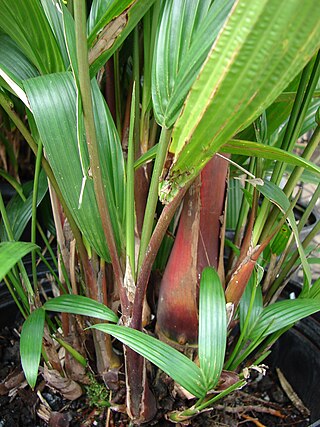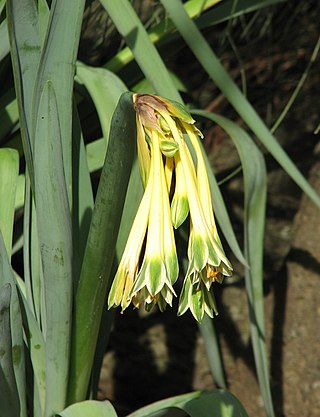
Royal Botanic Gardens, Kew is a non-departmental public body in the United Kingdom sponsored by the Department for Environment, Food and Rural Affairs. An internationally important botanical research and education institution, it employs 1,100 staff. Its board of trustees is chaired by Dame Amelia Fawcett.

Guzmania is a genus of over 120 species of flowering plants in the botanical family Bromeliaceae, subfamily Tillandsioideae. They are mainly stemless, evergreen, epiphytic perennials native to Florida, the West Indies, southern Mexico, Central America, and northern and western South America. They are found at altitudes of up to 3,500 m (11,483 ft) in the Andean rainforests.

Lanaria is a monotypic genus of flowering plants containing a single species, Lanaria lanata, endemic to the southern coast of South Africa where it is associated with the fynbos belt. Lanaria lanata is commonly known as Cape edelweiss or lambtails. The genus is placed in the monotypic family Lanariaceae, a family only recently recognized by taxonomists. The APG IV system of 2016 does recognize this family.

Copernicia is a genus of palms native to South America and the Greater Antilles. Of the known species and nothospecies (hybrids), 22 of the 27 are endemic to Cuba. They are fan palms, with the leaves with a bare petiole terminating in a rounded fan of numerous leaflets. The species are small to medium-sized trees growing to 5–30 m tall, typically occurring close to streams and rivers in savanna habitats.

Reinhardtia is a genus in the palm family native to the northern Neotropics. It is a primarily Central American genus with five species distributed between southern Mexico and the extreme north of Colombia, and one isolated species, Reinhardtia paiewonskiana in the southwest of the Dominican Republic.
Cyphosperma is a genus of flowering plants in the family Arecaceae, native to various islands of the Pacific. It contains the following species:

Cyrtostachys is a genus of flowering plant in the family Arecaceae. Its species are found in southeast Asia, New Guinea, and in some of the South-Central and Southwest Pacific island habitats of the Oceanian realm.

Hyospathe is a genus of flowering plant in the family Arecaceae, native to South America and Central America. It contains the following species:
Marojejya is a genus of flowering plant in the family Arecaceae. It contains the following two species, both endemic to Madagascar:
Masoala is a genus of flowering plant in the family Arecaceae. It contains the following species, both endemic to Madagascar:

Oncosperma is a genus of flowering plant in the family Arecaceae. It contains the following species, native to Southeast Asia and Sri Lanka:

Parajubaea is a genus of flowering plant in the family Arecaceae.
Rhopaloblaste is a genus of flowering plant in the family Arecaceae, native to New Guinea, Melanesia and Southeast Asia.

Citronella aka Andreea is a genus of trees and shrubs in the family Cardiopteridaceae described as a genus in 1832. It is native to tropical regions of South and Central America, insular Southeast Asia, Australia, and islands of the western Pacific. The genus was formerly treated as belonging to the family Icacinaceae.

Dipentodontaceae is a family of flowering plants containing two genera.
- DipentodonDunn - southern China, Assam, Myanmar
- PerrottetiaKunth in F.W.H.von Humboldt - southern China, Southeast Asia, Papuasia, Queensland, Hawaii, Latin America.

Aerides multiflora, the multi-flowered aerides, is a species of orchid, native to Southeast Asia, the Coromandel Coast, and Bangladesh.
The World Checklist of Selected Plant Families was an "international collaborative programme that provides the latest peer reviewed and published opinions on the accepted scientific names and synonyms of selected plant families." Maintained by the Royal Botanic Gardens, Kew, it was available online, allowing searches for the names of families, genera and species, as well as the ability to create checklists.

Stenomesson is a genus of bulbous plants in the family Amaryllidaceae. All the species are native to western South America.

Clinanthus is a genus of bulbous plants in the family Amaryllidaceae, found in western South America, from Ecuador to north west Argentina.
Plants of the World Online (POWO) is an online database published by the Royal Botanic Gardens, Kew. It was launched in March 2017 with the ultimate aim being "to enable users to access information on all the world's known seed-bearing plants by 2020". The initial focus was on tropical African Floras, particularly Flora Zambesiaca, Flora of West Tropical Africa and Flora of Tropical East Africa.













